Wikipedia:Picture of the day/January 2024
|
Featured picture tools: |
These featured pictures, as scheduled below, appeared as the picture of the day (POTD) on the English Wikipedia's Main Page in January 2024. Individual sections for each day on this page can be linked to with the day number as the anchor name (e.g. [[Wikipedia:Picture of the day/January 2024#1]] for January 1).
You can add an automatically updating POTD template to your user page using {{Pic of the day}} (version with blurb) or {{POTD}} (version without blurb). For instructions on how to make custom POTD layouts, see Wikipedia:Picture of the day.Purge server cache
January 1
|
Steamboat Willie is a 1928 American animated short film directed by Walt Disney and Ub Iwerks. It marks Mickey Mouse and Minnie Mouse's first appearance in a distributed film. Mickey Mouse was created as a replacement for Oswald the Lucky Rabbit, created by the Disney studio but owned at the time by Universal Pictures, and when two silent films featuring Mickey failed to gain a distributor, Walt Disney decided instead to put him in a sound cartoon – perhaps inspired by The Jazz Singer. With music arranged by Wilfred Jackson and Bert Lewis, Steamboat Willie was one of the first cartoons with synchronized sound. The film received wide critical acclaim upon its release, and it has been preserved in the United States National Film Registry for its significance. The film enters the public domain under U.S. copyright law today (January 1, 2024), 95 years after its release in 1928. Film credit: Walt Disney Studios
Recently featured:
|
January 2

|
Le Violon d'Ingres is a black-and-white photograph taken by the American visual artist Man Ray in 1924. One of the best-known works of Surrealist photography, it was first published in the Surrealist magazine Littérature in June 1924. It shows the French model Kiki de Montparnasse from the back, nude to below her waist and wearing a turban. Two f-holes are painted on her back to make her body resemble a violin. Photograph credit: Man Ray
Recently featured:
|
January 3

|
|
The black-faced woodswallow (Artamus cinereus) is a species of woodswallow native to Australia (in which it is found throughout, apart from the eastern margin), New Guinea and the Sunda Islands, including Timor. It is 18 to 19 cm (7.1 to 7.5 in) long and the most widespread species in the family Artamidae. A mainly sedentary bird, it remains in arid and semi-arid areas even during dry conditions. Although it can be partly nomadic, the species prefers open eucalypt woodlands, scrub, and spinifex in arid and semi-arid conditions. The black-faced woodswallow is mainly insectivorous, being an aerial feeder that can soar, hover and dive to catch insect prey such as moths. It also often feeds on the ground taking ground insects, or insects caught on the wing to be dismembered. This black-faced woodswallow was photographed in Sturt National Park in New South Wales, Australia. Photograph credit: John Harrison
Recently featured:
|
January 4
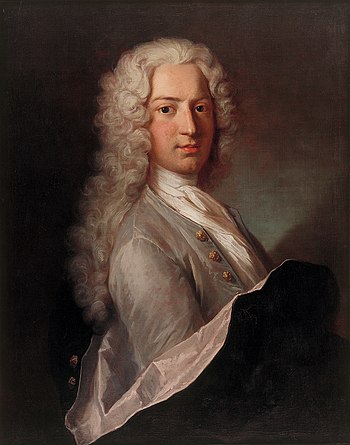
|
Daniel Bernoulli (1700–1782) was a Swiss mathematician and physicist, one of several prominent mathematicians of the Bernoulli family from Basel. He is particularly remembered for his applications of mathematics to mechanics, especially fluid mechanics, and for his pioneering work in probability and statistics. His name is commemorated in Bernoulli's principle, a particular example of the conservation of energy, and which describes the mathematics of the mechanism underlying the operation of two important technologies of the 20th century: the carburetor and the airplane wing. This oil-on-canvas portrait of Bernoulli, painted by an unknown artist, now hangs in the Basel Historical Museum. Painting credit: unknown
Recently featured:
|
January 5
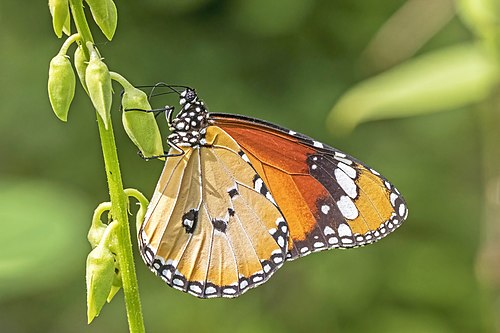
|
|
Danaus chrysippus, also known as the plain tiger or the African queen, belongs to the subfamily Danainae of the brush-footed butterfly family Nymphalidae. Its range extends across Africa and the majority of the Asian continent, as well as many South Pacific islands and some populations in Australia. It is found in a wide variety of habitats, although it is less likely to thrive in jungle-like conditions and is most often found in drier, wide-open areas. D. chrysippus is a medium-sized butterfly with a wingspan of about 7 to 8 centimetres (2.8 to 3.1 in). Its body is black with white spots, while the wings are a brownish orange, the upper side brighter and richer than the underside. It is a polymorphic species, so the exact colouring and patterning vary within and between populations. Its primary diet is milkweed plants, of the genus Asclepias. Because of its emetic properties, D. chrysippus is unpalatable to most predators. As a result, its colouration is widely mimicked by other species of butterfly. This photograph shows the underside of a male butterfly of the subspecies D. c. chrysippus, seen in Kumarakom, India. Photograph credit: Charles J. Sharp
Recently featured:
|
January 6

|
The Kefermarkt altarpiece is a richly decorated wooden altarpiece in the Late Gothic style in the parish church of Kefermarkt in Upper Austria. Commissioned by the knight Christoph von Zelking, it was completed around 1497. Saints Peter, Wolfgang and Christopher are depicted in the central section. The wing panels depict scenes from the life of Mary, and the altarpiece also has an intricate superstructure and two side figures of Saints George and Florian. The identity of its maker, known by the notname Master of the Kefermarkt Altarpiece, is unknown, but at least two skilled sculptors appear to have created the main statuary. Throughout the centuries, it has been altered and lost its original paint and gilding; a major restoration was undertaken in the 19th century under the direction of Adalbert Stifter. The altarpiece has been described as "one of the greatest achievements in late-medieval sculpture in the German-speaking area". This image shows the lower-right wing panel of the Kefermarkt altarpiece, depicting the Adoration of the Magi. Mary gazes on the infant Christ while one of the Magi is kneeling in front of him; the child plays with the gold in the box he is bringing. Both he and the second of the Magi, behind him, have taken off their hats as a mark of respect. Sculpture credit: Master of the Kefermarkt Altarpiece; photographed by Uoaei1
Recently featured:
|
January 7

|
Pinot gris, or pinot grigio, is a grape variety of the species Vitis vinifera used to make white wine. Thought to be a mutant clone of pinot noir, it normally has a pinkish-gray hue, accounting for its name, but the colors can vary from blue-gray to pinkish-brown. Pinot gris thrives in cooler climates, with the major growing regions being Alsace in France, northeastern Italy and the U.S. state of Oregon. The wines vary greatly with these regions; for example, Alsatian pinot gris wines are medium to full-bodied and tend to be spicy in comparison with others. This photograph of a bunch of pinot gris grapes was focus-stacked from twelve separate frames. Photograph credit: Reinhold Möller
Recently featured:
|
January 8

|
Portrait of Margaret van Eyck is a 1439 oil-on-wood painting by the Early Netherlandish artist Jan van Eyck. A portrait of his wife Margaret, it is one of the two latest of van Eyck's surviving paintings, and one of the earliest European artworks to depict a painter's spouse. It was completed when Margaret was around 34 and hung until the early 18th century in the chapel of the guild of painters in Bruges (in present-day Belgium). The work is thought to be a pendant or a diptych panel, with van Eyck himself occupying the other half in either a now lost self-portrait known from records until 1769, or his Portrait of a Man. This portrait of Margaret is now in the collection of the Groeningemuseum in Bruges. Painting credit: Jan van Eyck
Recently featured:
|
January 9

|
The jabiru (Jabiru mycteria) is a large stork found in the Americas from Mexico to Argentina, except west of the Andes, occasionally also moving into the southern United States. Its name comes from Tupi–Guarani and means 'swollen neck'. It is a tall bird, with larger males reaching a height of more than 1.5 metres (4.9 ft). It measures 2.3 to 2.8 metres (7.5 to 9.2 ft) across the wings, and can weigh up to 9 kilograms (20 lb). The plumage is mostly white, but the head and upper neck are featherless and black, with a featherless red stretchable patch at the base. This jabiru was photographed in the Pantanal area of Brazil. Photograph credit: Charles J. Sharp
Recently featured:
|
January 10

|
|
The château fort de Lourdes is a historic castle located in Lourdes in the department of Hautes-Pyrénées, France. It is strategically placed at the entrance to the seven valleys of the Lavedan. The castle's origins go back to Roman times, but today the oldest remains date from the 11th and 12th centuries and consist of the foundations of the present fortifications. The castle was reinforced in the 13th and 14th centuries (the construction of the keep), and again in the 17th and 19th centuries. From 1590, under the reign of King Henry IV, the castle became a prison, and was then later used as a barracks, before becoming a museum around the turn of the 20th century. Since 1933, it has been listed as a monument historique by the Ministry of Culture. This panoramic photograph shows the castle in 2018, with parts of the surrounding town and the peaks of the Pyrenees in the background. Photograph credit: Moahim
Recently featured:
|
January 11
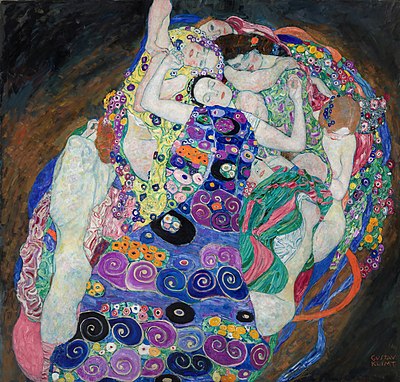
|
The Maiden is a painting by the Austrian artist Gustav Klimt, completed in 1913. It depicts seven interlaced women, each woman representing a particular stage of life. The painting touches on various topics of human life, such as love, sexuality and regeneration, depicted in a cyclical shape. The virgin's gown with its many spirals of blue and purple metaphorically indicates fertility, continual change and the evolution of the universe. The Maiden was one of Klimt's last paintings before he died and is in the collection of the National Gallery Prague in the Czech Republic. Painting credit: Gustav Klimt
Recently featured:
|
January 12

|
|
The dragonfly is a flying insect belonging to the infraorder Anisoptera of the order Odonata. About 3,000 extant species of true dragonflies are known. Most are tropical, with fewer species in temperate regions. Adult dragonflies are characterized by a pair of large, multifaceted, compound eyes, two pairs of strong, transparent wings, sometimes with coloured patches, and an elongated body. Many dragonflies have brilliant iridescent or metallic colours produced by structural coloration, making them conspicuous in flight. An adult dragonfly's compound eyes have nearly 24,000 ommatidia each. Dragonflies are predatory insects, both in their aquatic nymphal stage (also known as "naiads") and as adults. In some species, the nymphal stage lasts up to five years, and the adult stage may be as long as 10 weeks, but most species have an adult lifespan in the order of five weeks or less, and some survive for only a few days. Loss of wetland habitat threatens dragonfly populations around the world. This male Onychogomphus forcipatus dragonfly was photographed in Kresna Gorge, Bulgaria. Photograph credit: Charles J. Sharp
Recently featured:
|
January 13

|
|
The Roman amphitheatre of Italica is a ruined Roman amphitheatre situated outside the ancient Roman settlement of Italica in Andalusia, Spain, near the modern city of Seville. It was built during the reign of the emperor Hadrian (who was born in Italica), approximately between the years 117 and 138, and was one of the largest amphitheatres in the Roman Empire. With a capacity of 25,000 spectators, it had an elliptical shape of around 160 by 137 metres (525 by 449 ft), with three levels of stands: the first of these remains intact, the second partially so, and the third is mostly in ruin. The amphitheatre, along with the rest of Italica, was largely abandoned by the Romans in the 3rd century. It was rediscovered in the 17th century during the Renaissance, and work to unearth the amphitheatre began in the late 19th century. It is now a tourist site offering visitor tours, and also featured in the TV series Game of Thrones as the dragonpit of King's Landing. This panoramic photograph shows the interior of the amphitheatre in 2015. Photograph credit: Diego Delso
Recently featured:
|
January 14
|
The gold dollar is a gold coin that was struck as a regular issue by the United States Bureau of the Mint from 1849 to 1889. It had three types over its lifetime, all designed by Mint Chief Engraver James B. Longacre. The Type 1 issue had the smallest diameter of any United States coin ever minted. A gold dollar had been proposed several times in the 1830s and 1840s, but was not initially adopted. Congress was finally galvanized into action by the increased supply of bullion from the California gold rush, and in 1849 authorized a gold dollar. In its early years, silver coins were being hoarded or exported, and the gold dollar found a ready place in commerce. Silver again circulated after Congress required in 1853 that new coins of that metal be made lighter, and the gold dollar became a rarity in commerce even before federal coins vanished from circulation amid the economic disruption of the American Civil War. Gold did not circulate again in most of the nation until 1879, and even then, the gold dollar did not regain its place in commerce. In its final years, struck in small numbers, it was hoarded by speculators and mounted in jewelry. Coin design credit: United States Mint
Recently featured:
|
January 15

|
|
The buff-banded rail (Hypotaenidia philippensis) is a medium-sized bird in the rail family, Rallidae. It comprises several subspecies found throughout much of Australasia and the south-west Pacific region, covering a range of latitudes from the tropics to the subantarctic. It utilises a range of moist or wetland habitats with low, dense vegetation for cover. The buff-banded rail is a largely terrestrial bird with the size of a small domestic chicken, with mainly brown upperparts, finely banded black-and-white underparts, a white eyebrow, and a chestnut band running from the bill round the nape, with a buff band on the breast. It is an omnivorous scavenger that feeds on a range of terrestrial invertebrates and small vertebrates, seeds, fallen fruit and other vegetable matter, as well as carrion and refuse. This buff-banded rail was photographed in Newington, New South Wales. Photograph credit: JJ Harrison
Recently featured:
|
January 16

|
Lightning is a natural phenomenon formed by electrostatic discharges through the atmosphere between two electrically charged regions, either both in the atmosphere or one in the atmosphere and one on the ground, temporarily neutralizing these in a near-instantaneous release of an average of between 200 megajoules and 7 gigajoules of energy, depending on the type. The three main types of lightning are distinguished by where they occur: either inside a single thundercloud (intra-cloud), between two clouds (cloud-to-cloud), or between a cloud and the ground (cloud-to-ground), in which case it is referred to as a lightning strike. Lightning causes thunder, a sound from the shock wave which develops as gases in the vicinity of the discharge heat suddenly to very high temperatures. It is often heard a few seconds after the lightning itself. Thunder is heard as a rolling, gradually dissipating rumble because the sound from different portions of a long stroke arrives at slightly different times. This photograph shows strokes of cloud-to-ground lightning hitting the Mediterranean Sea close to Port-la-Nouvelle in southern France. Photograph credit: Maxime Raynal
Recently featured:
|
January 17
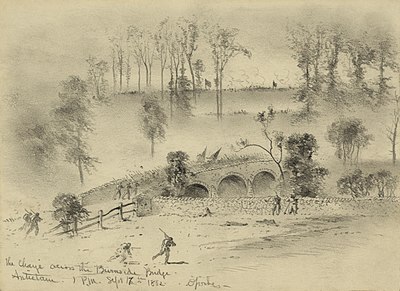
|
The Battle of Antietam, also known as the Battle of Sharpsburg, was a battle of the American Civil War fought on September 17, 1862, between Confederate general Robert E. Lee's Army of Northern Virginia and Union general George B. McClellan's Army of the Potomac near Sharpsburg, Maryland, and Antietam Creek. Part of the Maryland campaign, it was the first field army–level engagement in the eastern theater of the American Civil War to take place on Union soil. It remains the bloodiest day in American history, with a combined tally of 22,727 dead, wounded, or missing. Although the Union Army suffered heavier casualties than the Confederates, the battle was a major turning point in the Union's favor. This 1862 illustration by Edwin Forbes shows the charge across Burnside's Bridge, which took place during the Battle of Antietam. Illustration credit: Edwin Forbes; restored by Adam Cuerden
Recently featured:
|
January 18
Photograph credit: Llez
Recently featured:
|
January 19

|
Billy Bowlegs (c. 1810 – 1859), real name Holata Micco (Alligator Chief), was an important leader of the Seminoles in Florida during the Second Seminole War and was the remaining Seminoles' most prominent chief during the Third Seminole War, in which he led the Seminoles' last major resistance against the United States government. With the possibilities of military victory dwindling, he finally agreed to relocate with his people to Indian Territory (present-day Oklahoma) in 1858. As part of the settlement he was paid $6,500, plus $1,000 each for the subchiefs and $100 each for the women and children who went with him. This lithograph of Bowlegs was produced by an unknown engraver around 1865 to 1870, based on an original work by Julian Vannerson. Lithograph credit: unknown, after Julian Vannerson; restored by Adam Cuerden
Recently featured:
|
January 20

|
Ely Cathedral is an Anglican cathedral in the city of Ely in Cambridgeshire, England. The cathedral can trace its origin to an abbey founded in Ely in 672 by St Æthelthryth (also called Etheldreda). The earliest parts of the present building date to 1083, and it was granted cathedral status in 1109. Until the Reformation the cathedral was dedicated to St Etheldreda and St Peter, at which point it was refounded as the Cathedral Church of the Holy and Undivided Trinity of Ely. It is the cathedral of the Diocese of Ely and seat of the Bishop of Ely. Ely Cathedral was built in a monumental Romanesque style, with the galilee porch, lady chapel and choir later rebuilt in an exuberant Decorated Gothic. Its central octagonal tower and the West Tower give it a prominent position above the surrounding flat landscape. This photograph shows the cathedral's lady chapel. Photograph credit: David Iliff
Recently featured:
|
January 21
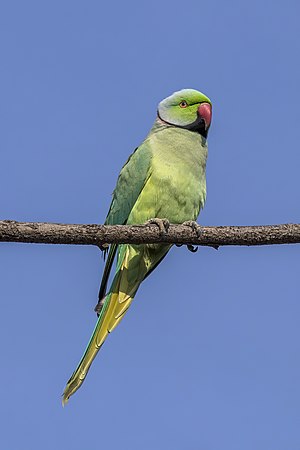
|
The rose-ringed parakeet (Psittacula krameri) is a medium-sized parrot in the family Psittacidae. It has disjunct native ranges in Africa and the Indian subcontinent, and has been introduced into many other parts of the world, including northern Europe, where feral populations have established themselves in urban areas and are bred for the exotic pet trade. Wild populations have a distinctive green colour, red beak and blue tail with adult males sporting a pink and black neck ring. This male rose-ringed parakeet of the subspecies P. k. borealis was photographed in Jaipur in Rajasthan, India. Photograph credit: Charles J. Sharp
Recently featured:
|
January 22

|
|
The 1854 Broad Street cholera outbreak was a severe outbreak of cholera that occurred near Broad Street (now Broadwick Street), in the London district of Soho, during the 1846–1860 worldwide cholera pandemic. The outbreak, which killed 616 people and had a mortality rate of 12.8 per thousand in some areas, is best known for the study of its causes by the physician John Snow and his hypothesis that germ-contaminated water was the source of cholera, rather than particles in the air (referred to as miasma). This discovery came to influence public health and the construction of improved sanitation facilities beginning in the mid–19th century. This dot map of Soho drawn by Snow shows clusters of cholera cases (indicated by stacked rectangles) in the 1854 outbreak. He identified a contaminated pump, located at the junction of Broad Street and Cambridge Street, as the source. The map, published in Snow's book On the Mode of Communication of Cholera, marks an important part of the development of epidemiology as a field, and of disease mapping as a whole. Map credit: John Snow
Recently featured:
|
January 23

|
Junonia orithya, commonly known as the blue pansy or the blue argus, is a nymphalid butterfly with many subspecies occurring from Africa, through southern and south-eastern Asia, and Australia. Both males and females have predominantly velvety black, blue, orange and white colouring, with females being slightly larger than males and with more clearly defined ocelli and markings. This male J. orithya butterfly was photographed in Periyar National Park in Kerala, India. Photograph credit: Jeevan Jose
Recently featured:
|
January 24

|
The Mac (known as the Macintosh until 1999) is a family of personal computers designed and marketed by Apple Inc. The product lineup includes the MacBook Air and MacBook Pro laptops, and the iMac, Mac Mini, Mac Studio, and Mac Pro desktops. Macs are sold with the macOS operating system, previously known as OS X. The Macintosh project was conceived by Jef Raskin in 1979 and then redefined in 1981 by Apple co-founder Steve Jobs, the first model being introduced in 1984 through an advertisement played during Super Bowl XVIII. The product evolved with the introduction of color in 1987 with the Macintosh II, and a new processor line in the Power Macintosh in 1994. Through most of the 1990s, the Mac was not fully competitive with commodity IBM PC compatibles. Steve Jobs returned to Apple in 1996 and subsequently returned the Mac to the mainstream with the launch of the iMac series OS X. Many users, especially professionals, felt that the Mac was neglected during the 2010s under CEO Tim Cook, but a new line of Macs with the Apple silicon chipset has received more positive reviews. This photograph shows Jobs with the first Mac, at the time of its launch on January 24, 1984. The image on the computer screen is a digitized version of A Woman Combing Her Hair, a painting by the Japanese artist Goyō Hashiguchi. Photograph credit: Bernard Gotfryd; edited by W.carter and Janke
Recently featured:
|
January 25
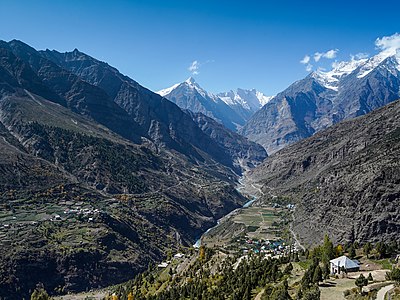
|
Lahaul and Spiti is a district of the northern Indian state of Himachal Pradesh. Located in the Himalayas, it was formed by the merger of the districts of Lahaul and Spiti in 1960. At the 2011 census of India, it was the least densely populated district of India. This photograph shows the valley of the Bhaga River in Lahaul, with the villages of Kardang (left) and Biling (right) visible on opposite sides of the river, near the district headquarters of Kyelang. Photograph credit: Timothy A. Gonsalves
Recently featured:
|
January 26

|
Kenje Ogata (1919–2012) was a Japanese American who served in the United States Army Air Corps during World War II. Born in Gary, Indiana, he grew up in Sterling, Illinois, and went on to earn his pilot's license through the Civilian Pilot Training Program. Following the bombing of Pearl Harbor in 1941, Ogata applied to join the armed forces. Due to his Japanese heritage he was discouraged from joining, but he insisted, telling the recruitment office "I am here to serve". In 1943, Ogata was assigned to the Fifteenth Air Force in Italy, training as a ball turret gunner. He rose to the rank of staff sergeant, completed thirty-five missions, and survived two crashes. For his service and injuries sustained in combat, he received the Air Medal with three bronze oak leaf clusters and the Purple Heart. This portrait of Ogata in uniform was taken in 1943. Photograph credit: unknown photographer; restored by Adam Cuerden
Recently featured:
|
January 27

|
The Indian pied myna (Gracupica contra) is a species of starling found in the Indian subcontinent, with a principal distribution from the Gangetic plains extending south to the Krishna River. This range has increased in recent times, with populations established in Pakistan, western India and also Dubai. The spread has been aided by changes in irrigation and farming patterns and accidental escape of caged birds. The Indian pied myna is found mainly in lowland open areas with scattered trees near water, often near human habitation, but also inhabits areas up to around 700 metres (2,300 ft) in altitude. It has a black and white plumage with a yellowish bill and a reddish bill base. This pair of Indian pied mynas was photographed outside the city of Hapur in Uttar Pradesh, India. Photograph credit: Charles J. Sharp
Recently featured:
|
January 28

|
|
The Space Shuttle Challenger disaster was the first fatal accident to an American spacecraft in flight. On January 28, 1986, the Space Shuttle Challenger broke apart 73 seconds into the flight of STS-51-L, the 25th mission of NASA's Space Shuttle program. All seven crew members aboard were killed. The spacecraft disintegrated 46,000 feet (14 km) above the Atlantic Ocean, off the coast of Cape Canaveral, Florida, at 11:39 am EST. This official portrait of the STS-51-L crew was taken on November 15, 1985. In the back row, from left to right, are Ellison Onizuka, Christa McAuliffe, Gregory Jarvis, and Judith Resnik. In the front row, from left to right, are Michael J. Smith, Dick Scobee, and Ronald McNair. Photograph credit: NASA
Recently featured:
|
January 29
|
Cyrano de Bergerac is a 1950 American adventure comedy film based on the 1897 French verse drama Cyrano de Bergerac by Edmond Rostand. It uses the poet Brian Hooker's 1923 English blank-verse translation as the basis for its screenplay. The film was the first motion picture version in English of Rostand's play, though there were several earlier adaptations in different languages. The 1950 film was produced by Stanley Kramer and directed by Michael Gordon. José Ferrer received the Academy Award for Best Actor for his starring performance as Cyrano de Bergerac. Mala Powers played Roxane, and William Prince portrayed Christian de Neuvillette. Film credit: Michael Gordon
Recently featured:
|
January 30

|
|
The redcurrant (Ribes rubrum) is a deciduous shrub in the gooseberry family, Grossulariaceae, which is native to western Europe. The plant normally grows to a height of up to one metre (3 ft), with its leaves arranged spirally on the stems. The flowers are inconspicuous yellow-green, maturing into bright red translucent edible berries. An established redcurrant bush can produce 3 to 4 kilograms (7 to 9 lb) of berries from mid- to late summer. The species is widely cultivated, with the berries known for their tart flavor, a characteristic provided by a relatively high content of organic acids and mixed polyphenols. This photograph of a bunch of redcurrant berries was focus-stacked from 15 separate images. Photograph credit: Ivar Leidus
Recently featured:
|
January 31

|
Brookesia thieli, commonly known as Domergue's leaf chameleon, is a species of lizard in the chamaeleon family, Chamaeleonidae. The species is endemic to eastern Madagascar. It was first described in 1969 by Édouard-Raoul Brygoo and Charles Antoine Domergue. This B. thieli lizard was photographed on a leaf in Andasibe, Madagascar. Photograph credit: Charles J. Sharp
Recently featured:
|
Picture of the day archives and future dates





